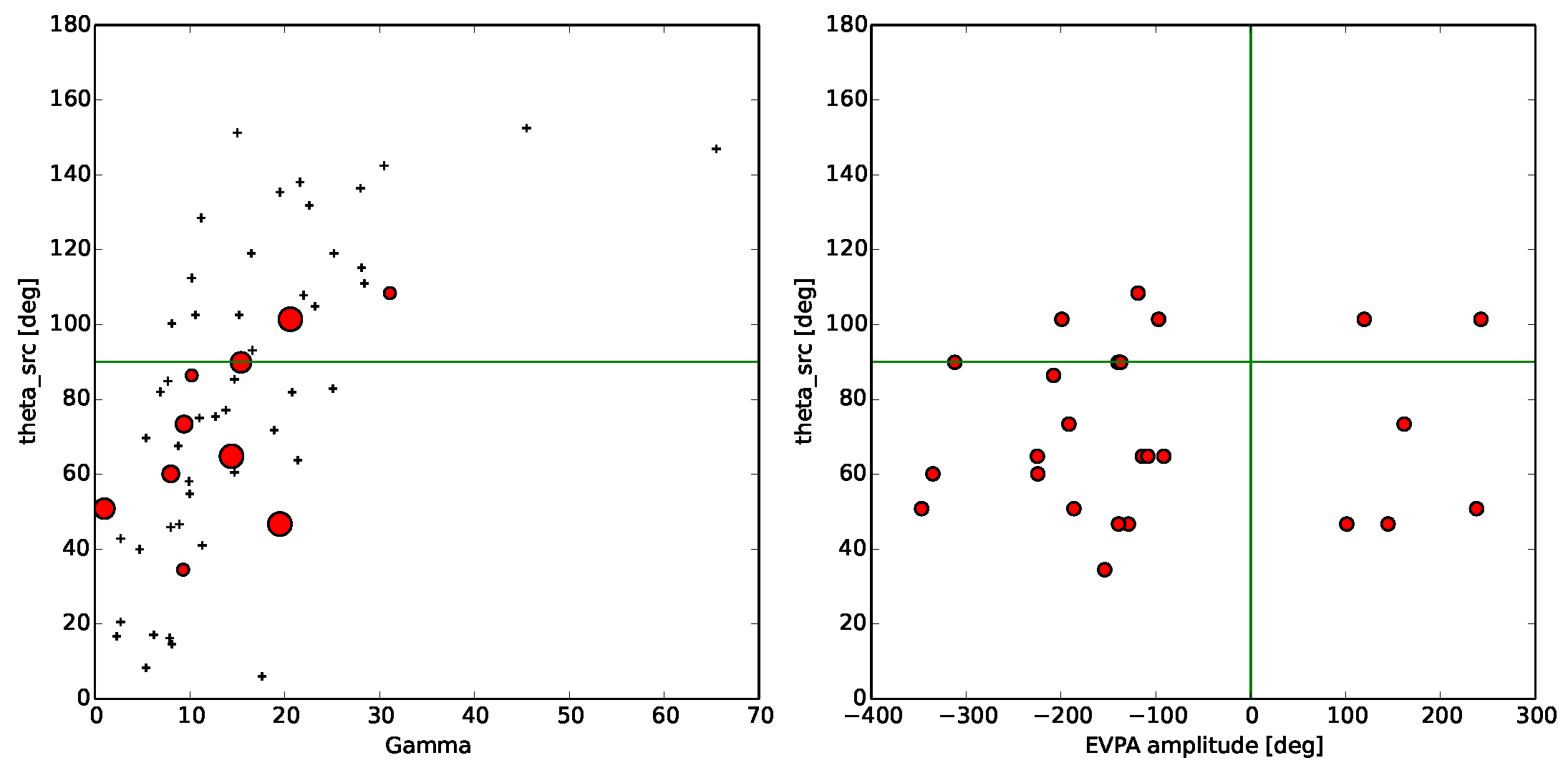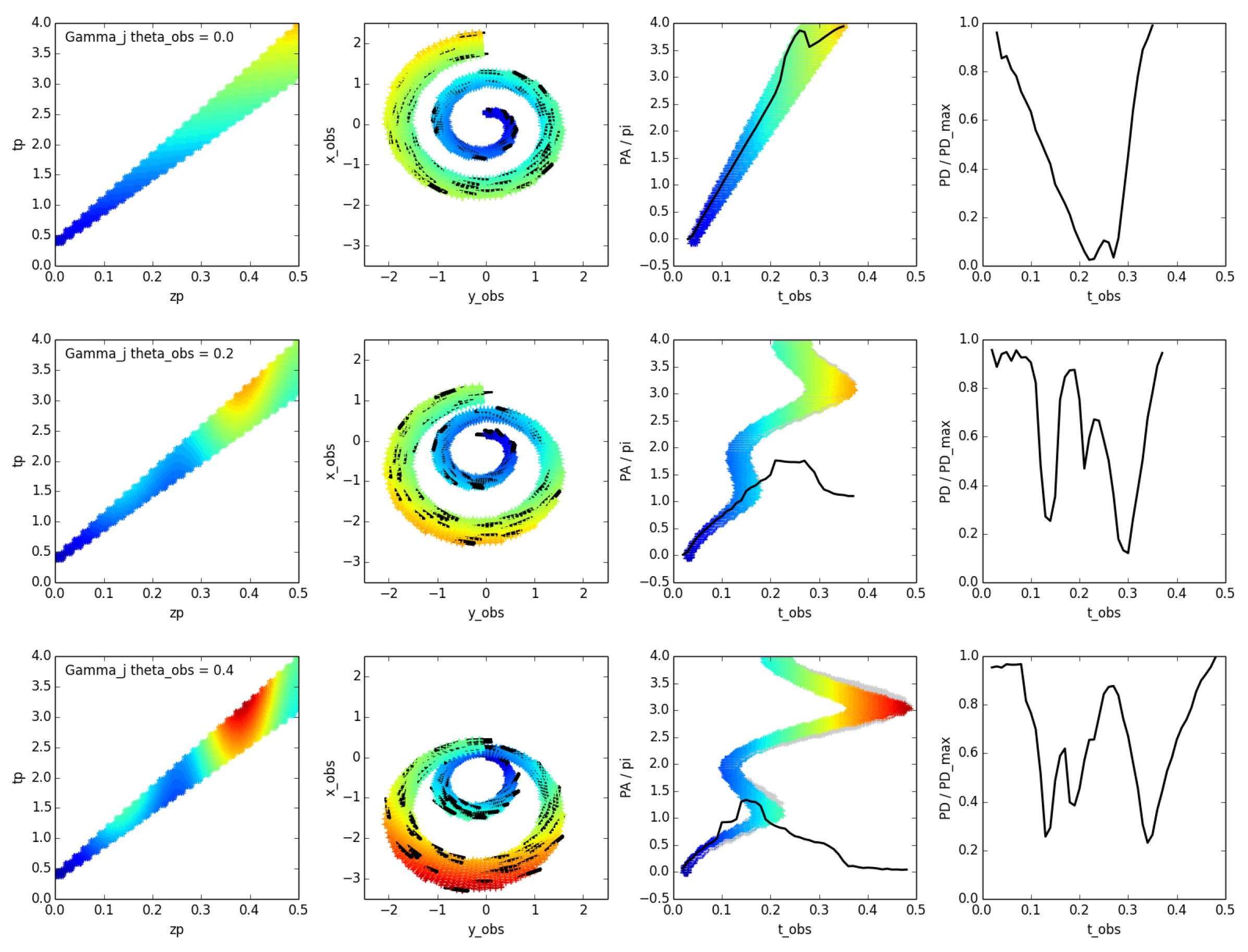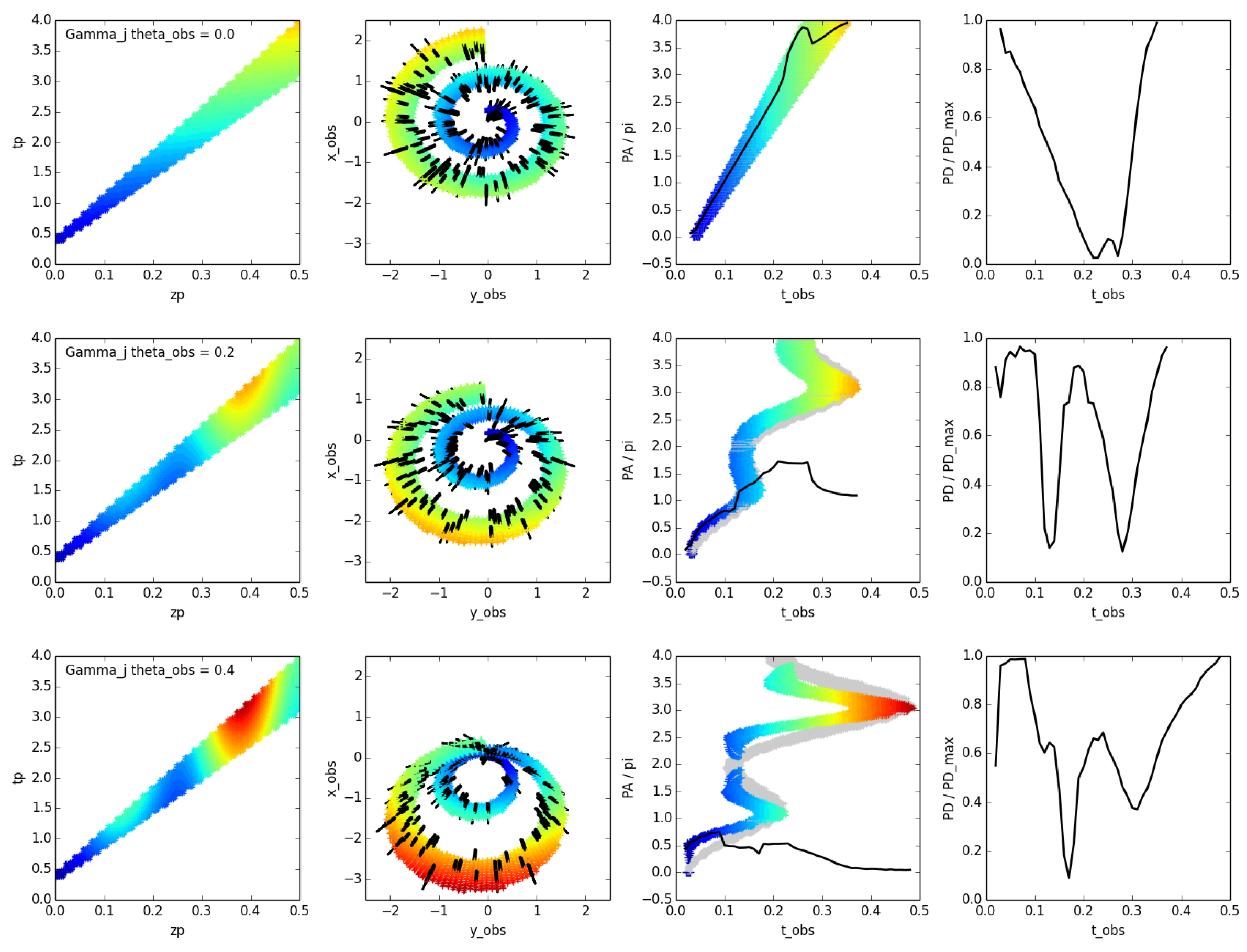A Model of Polarisation Rotations in Blazars from Kink Instabilities in Relativistic Jets
Abstract
:1. Introduction
- What could be the mechanism connecting optical polarisation rotations with high-energy flares in blazars? (Section 2.1)
- Is the distinction between rotator and non-rotator blazars due to different viewing angles? (Section 2.2)
- The presentation of a novel toy model of polarisation rotations from the development of kink instability in a relativistic conical jet. (Section 2.3)
- The importance of intrinsic depolarisation in limiting the amplitude of polarisation rotations.
2. Results
2.1. On the Connection between Polarisation Rotations and High-Energy Flares in Blazars
2.2. Whether Relativistic Aberration Can Explain the Occurrence of Rotators and Non-Rotators
2.3. A Model of Polarisation Rotations from Kink Instability
3. Materials and Methods: Definition of the Kink Model
4. Conclusions
Acknowledgments
Conflicts of Interest
References
- Madejski, G.M.; Sikora, M. Gamma-Ray Observations of Active Galactic Nuclei. Annu. Rev. Astron. Astrophys. 2016, 54, 725–760. [Google Scholar] [CrossRef]
- Marscher, A.P. The inner jet of an active galactic nucleus as revealed by a radio-to-gamma-ray outburst. Nature 2008, 452, 966. [Google Scholar] [CrossRef] [PubMed]
- Marscher, A.P.; Jorstad, S.G.; Larionov, V.M. Probing the Inner Jet of the Quasar PKS 1510-089 with Multi-Waveband Monitoring During Strong Gamma-Ray Activity. Astrophys. J. 2010, 710, L126. [Google Scholar] [CrossRef]
- Blinov, D.; Pavlidou, V.; Papadakis, I. RoboPol: First season rotations of optical polarisation plane in blazars. Mon. Not. R. Astron. Soc. 2015, 453, 1669–1683. [Google Scholar] [CrossRef]
- Blinov, D.; Pavlidou, V.; Papadakis, I. RoboPol: Do optical polarisation rotations occur in all blazars? Mon. Not. R. Astron. Soc. 2016, 462, 1775–1785. [Google Scholar] [CrossRef]
- Jones, T.W.; Rudnick, L.; Fiedler, R.L.; Aller, H.D.; Aller, M.F.; Hodge, P.E. Magnetic field structures in active compact radio sources. Astrophys. J. 1985, 290, 627–636. [Google Scholar] [CrossRef]
- Kiehlmann, S.; Blinov, D.; Pearson, T.J.; Liodakis, I. Optical EVPA rotations in blazars: Testing a stochastic variability model with RoboPol data. arXiv, 2017; arXiv:1708.06777. [Google Scholar]
- Nalewajko, K. Polarization Swings from Curved Trajectories of the Emitting Regions. Int. J. Mon. Phys. D 2010, 19, 701–706. [Google Scholar] [CrossRef]
- Lyutikov, M.; Kravchenko, E.V. Polarization swings in blazars. Mon. Not. R. Astron. Soc. 2017, 467, 3876–3886. [Google Scholar] [CrossRef]
- Zhang, H.; Chen, X.; Böttcher, M.; Guo, F.; Li, H. Polarization Swings Reveal Magnetic Energy Dissipation in Blazars. Astrophys. J. 2015, 804, 58. [Google Scholar] [CrossRef]
- Marscher, A.P.; Jorstad, S.G.; Agudo, I.; MacDonald, N.R.; Scott, T.L. Relation between Events in the Millimeter-wave Core and Gamma-ray Outbursts in Blazar Jets. arXiv, 2012; arXiv:1204.6707. [Google Scholar]
- León-Tavares, J.; Valtaoja, E.; Tornikoski, M.; Lähteenmäki, A.; Nieppola, E. The connection between gamma-ray emission and millimeter flares in Fermi/LAT blazars. Astron. Astrophys. 2011, 532, A146. [Google Scholar] [CrossRef]
- Nalewajko, K.; Begelman, M.C.; Sikora, M. Constraining the Location of Gamma-Ray Flares in Luminous Blazars. Astrophys. J. 2014, 789, 161. [Google Scholar] [CrossRef]
- Begelman, M.C. Instability of Toroidal Magnetic Field in Jets and Plerions. Astrophys. J. 1998, 493, 291. [Google Scholar] [CrossRef]
- Bromberg, O.; Tchekhovskoy, A. Relativistic MHD simulations of core-collapse GRB jets: 3D instabilities and magnetic dissipation. Mon. Not. R. Astron. Soc. 2016, 456, 1739–1760. [Google Scholar] [CrossRef]
- Komissarov, S.S. Ram-Pressure Confinement of Extragalactic Jets. Mon. Not. R. Astron. Soc. 1994, 266, 649–652. [Google Scholar] [CrossRef]
- Savolainen, T.; Homan, D.C.; Hovatta, T.; Kadler, M.; Kovalev, Y.Y.; Lister, M.L.; Ros, E.; Zensus, J.A. Relativistic beaming and gamma-ray brightness of blazars. Astron. Astrophys. 2010, 512, A24. [Google Scholar] [CrossRef]
- Blinov, D.; Pavlidou, V.; Papadakis, I.E. RoboPol: Optical polarisation-plane rotations and flaring activity in blazars. Mon. Not. R. Astron. Soc. 2016, 457, 2252–2262. [Google Scholar] [CrossRef]
- Zhang, H.; Li, H.; Guo, F.; Taylor, G. Polarization Signatures of Kink Instabilities in the Blazar Emission Region from Relativistic Magnetohydrodynamic Simulations. Astrophys. J. 2017, 835, 125. [Google Scholar] [CrossRef]
- Nalewajko, K. Polarization of synchrotron emission from relativistic reconfinement shocks. Mon. Not. R. Astron. Soc. 2009, 395, 524–530. [Google Scholar] [CrossRef]



© 2017 by the author. Licensee MDPI, Basel, Switzerland. This article is an open access article distributed under the terms and conditions of the Creative Commons Attribution (CC BY) license (http://creativecommons.org/licenses/by/4.0/).
Share and Cite
Nalewajko, K. A Model of Polarisation Rotations in Blazars from Kink Instabilities in Relativistic Jets. Galaxies 2017, 5, 64. https://doi.org/10.3390/galaxies5040064
Nalewajko K. A Model of Polarisation Rotations in Blazars from Kink Instabilities in Relativistic Jets. Galaxies. 2017; 5(4):64. https://doi.org/10.3390/galaxies5040064
Chicago/Turabian StyleNalewajko, Krzysztof. 2017. "A Model of Polarisation Rotations in Blazars from Kink Instabilities in Relativistic Jets" Galaxies 5, no. 4: 64. https://doi.org/10.3390/galaxies5040064





